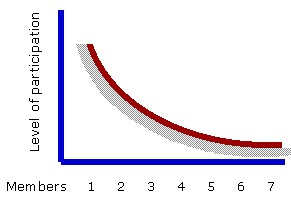One unsung piece of research into group processes is an old study by Bales et al (1951) which looked, among other things, at the level of participation of members in groups of up to seven people. Various factors affect this, which need not concern us, but the most striking finding was the shape of the curve of the level of contributions from the highest-contributing member to the lowest.
 In various conditions, the absolute level of contribution varies, of course—but the relative level between members holds to a constant pattern. The most vocal member contributes a lot, and it then tails away to the least vocal. This is a trivial finding, you may think—how could it be otherwise?
In various conditions, the absolute level of contribution varies, of course—but the relative level between members holds to a constant pattern. The most vocal member contributes a lot, and it then tails away to the least vocal. This is a trivial finding, you may think—how could it be otherwise?
That is a fair point, but the moral of the study is that members do and will not contribute equally: some will always have more to say than others, and despite our efforts as teachers (we are of course usually the most vocal members), we are never going to achieve equal participation.
So stop worrying about it: just as you can't make Storming go away, you can't make everyone contribute equally.
What you can do, of course, is to ensure that there are no obstacles to any particular student contributing— that there are truly equal opportunities within the class. In school classes, there are conventions about raising your hand before you speak, seeking recognition and permission from the teacher. Although these sometimes apply in classes of older students, particularly in very large groups, it is often a less formal matter of "catching the teacher's eye". It is important to keep looking around to give everyone the opportunity to do that. You can also make efforts to catch a student's eye and give an encouraging nod to help them to get in to the discussion, or you can nominate individuals: on the whole, however, that should be done sparingly. Too much gate-keeping of speaking opportunities can lead to stilted exchanges, in which the teacher has to respond to every contribution, and the interaction between class members themselves becomes very limited.
Shutting up the vocal members is often as much of a problem, and there are many aspects to this common behaviour pattern — it is a matter of finding the right note for each excessive contributor.
- Some people talk to get your — and the class's attention. If you don't reinforce them for talking too much, they may initially try harder, but then let up a bit. So ignore them as far as is consistent with politeness and respect.
- Room layout matters: if the students are in rows, you have to be more active.
- Repeat the main point and then ask, "What do other people think of that...?" It respects the contribution and most people will shut up to allow other to respond to what is, after all, their point. (And of course, since students may often be addressing their fellows from behind, it ensures that the point gets heard.)
- If you don't want to take up the point at all, ask them to hold it for a more appropriate occasion:
- "That's interesting—you're ahead of us! Raise it again when we discuss..."
- "That refers back to a couple of sessions ago: it's worth noting and we may come back to it, but at the moment..."
- "That raises a whole other set of issues! Let's stick with the main point for the moment. Hold on to it and raise in the wind-up session." (Either they will or they won't: if the point is just for process purposes, they'll forget it.)
- Some people never stop talking because, paradoxically, they are not sure of their ability to communicate. Ignoring them will only tell them they have to explain in even more detail, so they need to know you have heard what they have said.
- Some people are responding to covert messages from the rest of the class (or even yourself) to fill in silences: it's just a role they are comfortable with.
All you need to do is to manage the immediate group situation: you rarely have any brief or authority to try to change someone's accustomed pattern of social interaction, but you do have authority and responsibility to give everyone the same chance to contribute, so active and up-front intervention — perhaps leavened by a little humour — is perfectly acceptable.
Reference
BALES R F, STRODTBECK F L, MILLS T M and ROSENBOROUGH M (1951) "Channels of communication in small groups" American Sociological Review 16 pp. 461-467: reported in ROBINSON M (1984) Groups Chichester; John Wiley
This is an archived copy of Atherton J S (2013) Learning and Teaching [On-line: UK] Original material by James Atherton: last up-dated overall 10 February 2013

This work is licensed under a Creative Commons Attribution-Noncommercial-No Derivative Works 3.0 Unported License.
"This site is independent and self-funded, although the contribution of the Higher Education Academy to its development via the award of a National Teaching Fellowship, in 2004 has been greatly appreciated."

